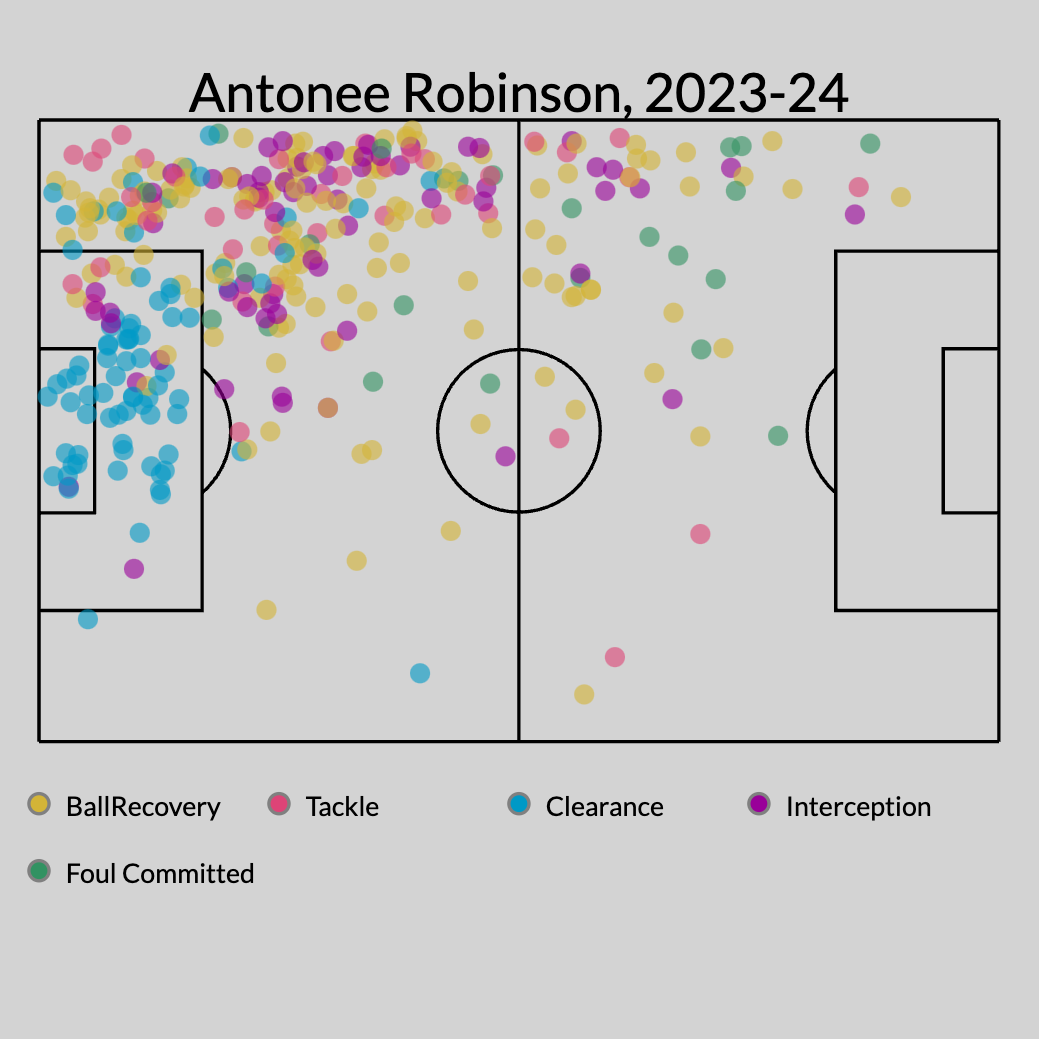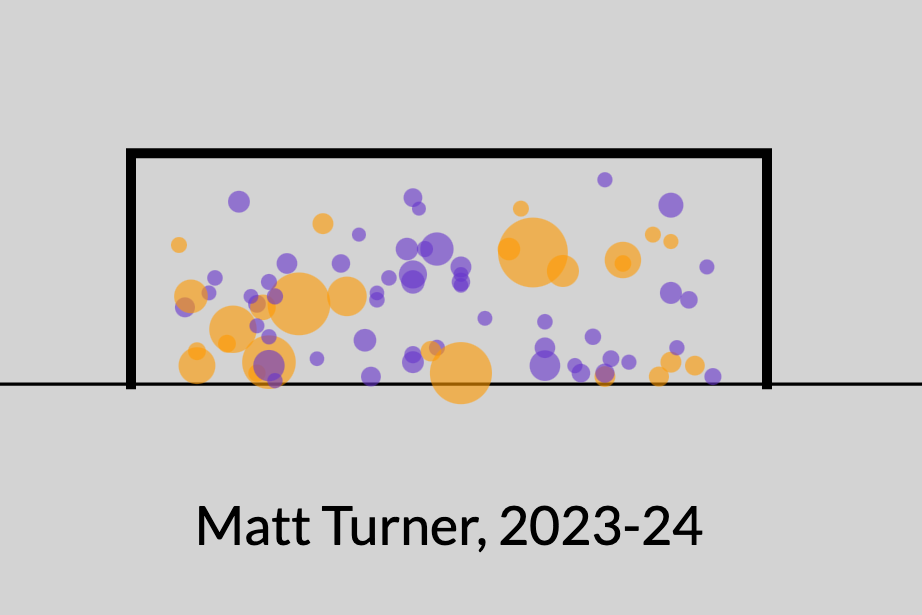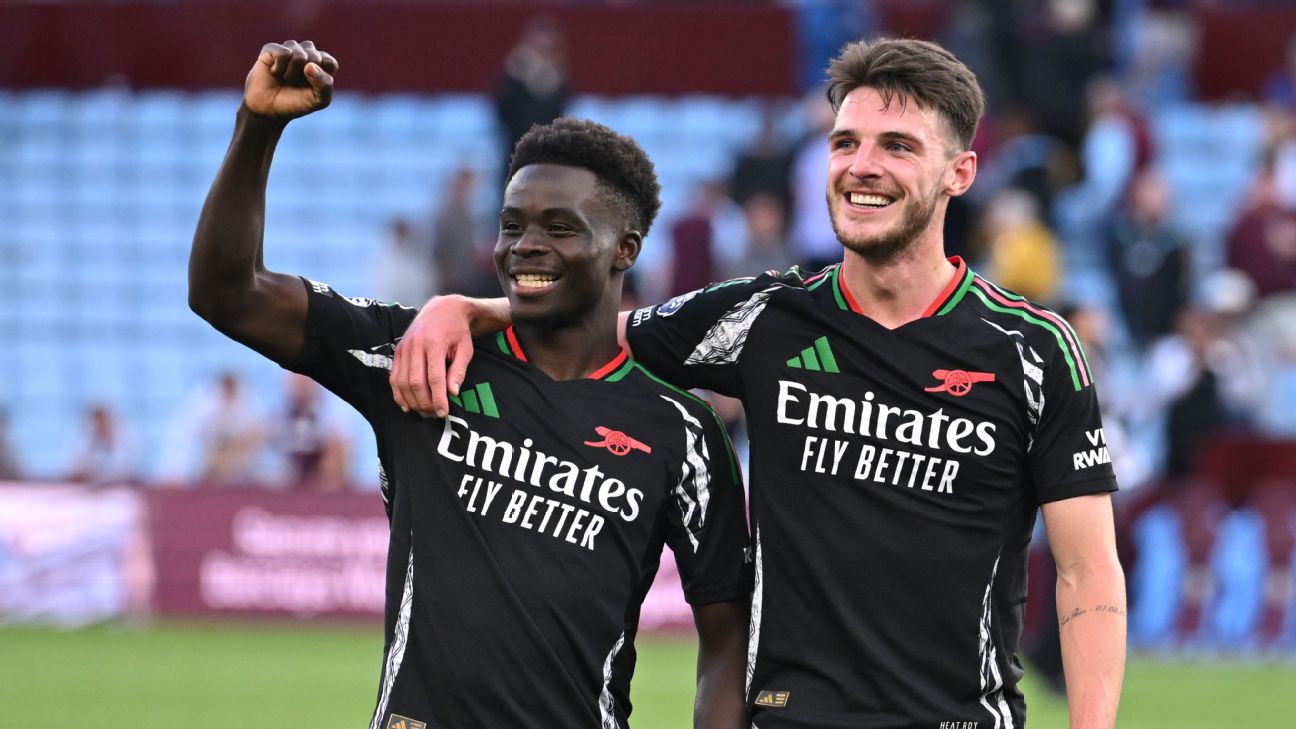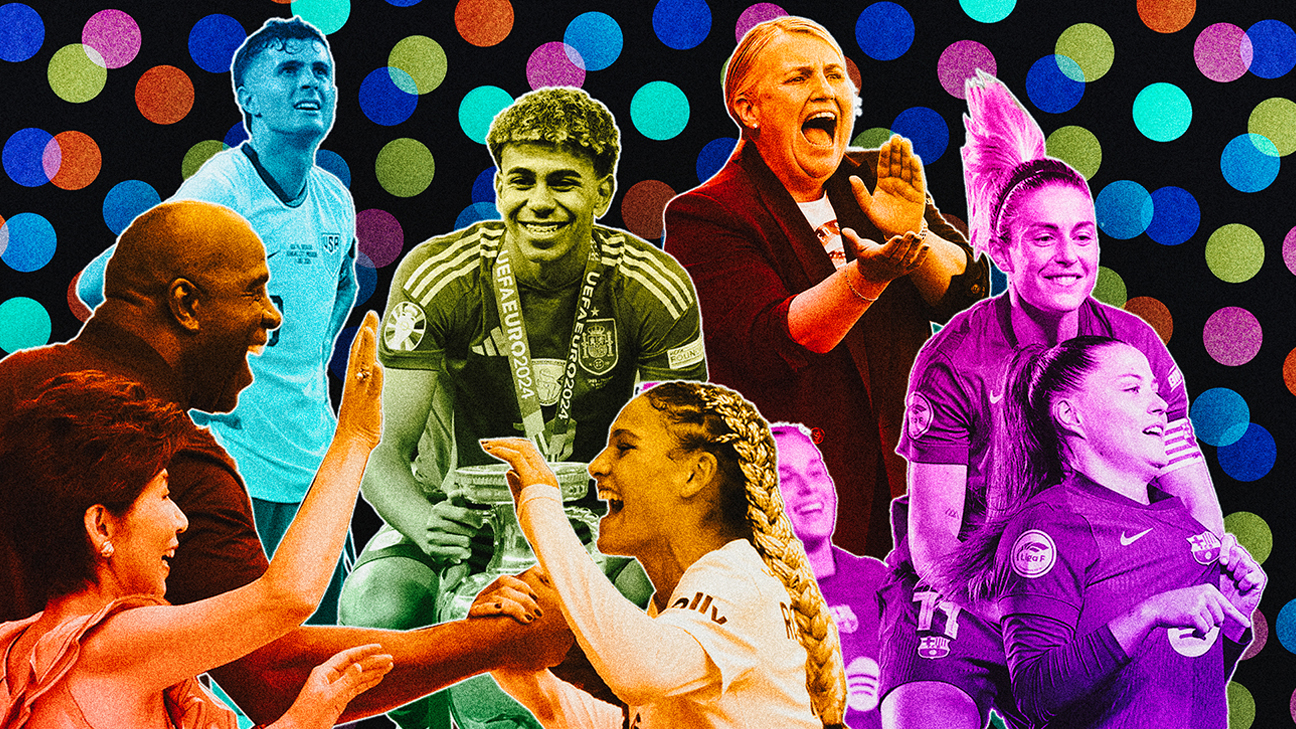The British statistician George Box famously wrote, “All models are wrong, but some are useful.” No model can be perfect — reality is too unpredictable and impossible to model — but the best ones reveal more about how the world works than we knew before.
And so welcome to ESPN’s not-exactly-right-but-useful new model: The USMNT Player Performance Index.
We wanted to come up with a way to track the progress of all of the top-level U.S. men’s national team players and rank them against one another over the course of the season. But how do you compare, say Timothy Weah fighting for playing time on Juventus with Haji Wright getting tons of minutes for Coventry City? How do you rate the performance of Matt Turner, a goalkeeper, against Christian Pulisic, a winger? What’s more valuable: coming off the bench for PSV Eindhoven or playing every minute for the Columbus Crew?
Figuring that out is part of the fun. These rankings are not meant to provide definitive evidence of the best American soccer player, but rather to give a bird’s-eye view of who is actually having an impact at the highest levels of the sport. In other words: Who is in form, and who isn’t?
Because individual statistics still miss so much of the context for player performance in soccer, we’ve instead opted for a top-down approach. To create the rankings, we’ve used three inputs: How much does a player play? How good is the team he plays for? And how does the team perform when he’s on the field, compared to off it?
The first part is simple: the percentage of available minutes played. If a USMNT player is trusted to start and play significant minutes for his team, there’s a strong likelihood it’s because he’s doing things that help his team. And if he’s not playing, he’s not providing any value, no matter how talented he might be.
The second output comes from Opta’s power ratings, which rank every club team in the world by a combination of their results, underlying performance and strength of opponent. Each team’s rating gets adjusted after every match — and the more a player plays, the more he contributes to that rating.
The third part of the rankings looks at the team’s goal differential per 90 minutes when the player is on the field compared to when he’s off it. Is his team better or worse when he’s on the field?
Team strength is the biggest component of the rankings (maximum value of 500 points), then playing time (max of 100 points), and then there’s a final minor adjustment for the on-off numbers (max adjustment of 10 points, in either direction). This is the first edition, and the formula might vary as the club season wears on.
Notable USMNT absences
A subjective list of the best players on the USMNT would look different, but our goal here is to provide an objective ranking of player form since the start of the current club season. That means some very good players have not landed in the top 50.
In another year, Tyler Adams would be here, and possibly topping the table, but since we’re attempting to look at this season, his zero minutes played mean he’s not on the list. Daryl Dike, too might’ve otherwise appeared somewhere on here, but he has played only 52 minutes this season for West Bromwich Albion after tearing his left Achilles just five games after returning from tearing his right Achilles.
Josh Sargent, meanwhile, misses out because he has played only 30% of the minutes for the seventh-place team in England’s second division. More consistent playing time, though, and we’ll see him on the next edition of this ranking.
Major League Soccer, too, poses a bit of difficulty for the first edition of these rankings. It’s too early in the season to have much confidence in team quality or to put too much weight onto how many minutes anyone has played. So, for now, we’ve used numbers from last season and player values from Transfermarkt to end up with six MLS players in our ranking. For the next edition, we’ll have a better baseline for how MLS and their teams are playing this season, which will allow more or different MLS players to break into the list.
With that out of the way, let’s dig into our ranking of the top 50 players right now, according to our USMNT Player Performance Index:

![]()
1. Christian Pulisic, winger, AC Milan
In the past, there was this idea in data analysis that if you’re creating a kind of player rating for soccer and Lionel Messi isn’t No. 1, then it means you need to start from scratch. We could probably apply a similar kind of thinking to the best American soccer player to ever live, too. If he’s not at or near the top, then we’re doing something wrong.
Although Pulisic’s goals and assists this season still trail below his underlying metrics, the core truth here is that he has played a ton of minutes for the 16th-best team in the world, per Opta, and the third-best team in Italy, per the Serie A table. After playing 2,011 combined domestic minutes across his final two seasons at Chelsea, he has nearly reached that mark in his first season at AC Milan: 1,838 minutes across 23 starts.
After a couple of years out in the wilderness, Pulisic needed to reestablish himself as a viable, consistent starter on a Champions League team. Based on that, Year 1 in Milan has been a massive success.
![]()
2. Weston McKennie, midfielder, Juventus
What a weird sport.
Just a year ago, Juventus were willing to let McKennie leave permanently for Leeds in the middle of the season. In other words, the most successful team in Italy sent a player to go play for a team in a relegation fight in England. With Leeds, McKennie was, in fact, relegated. But because he was relegated, his move to Leeds wasn’t made permanent. He returned to Juve — and then immediately became one of the most important players on the second-place team in Serie A.
At 25, McKennie is one of only three outfield players to play at least 2,000 league minutes for Juventus this season. Like Pulisic, he has proved (again) that he’s good enough to be a core starter on a team that’s good enough to play in the Champions League. You can count on one or two hands how many American soccer players we’ve ever been able to write that previous sentence about.
![]()
3. Sergiño Dest, fullback, PSV Eindhoven
Oh, and here’s another one!
Last time we saw Dest in a U.S. jersey, he was getting red-carded for punting the ball into the stands during a meaningless loss to Trinidad & Tobago in the second leg of the Nations League quarterfinals. Not exactly what you want. With PSV, though, he has been a fantastic attacking fullback for a team that’s 10 points ahead of second in the Eredivisie and tied with Borussia Dortmund, heading into the second leg of the Champions League round-of-16 matchup.
Per Opta, PSV rank as the 17th-best team in the world, one spot behind Pulisic’s AC Milan.
![]()
4. Antonee Robinson, fullback, Fulham
Were I just spitting this list out from my own head, I might have Robinson at No. 1. He has played 94% of the minutes for Fulham, and those are all grueling, super-high-energy minutes. Robinson has made 65 interceptions in the Premier League this season:

That’s 17 more than second place — or the same as the distance between second and 18th. Throw in five assists, and he has provided consistent, reliable two-way fullback play in the most difficult soccer league in the world.
![]()
5. Timothy Weah, fullback, Juventus
After the top four, there’s a big drop-off. Looking at the actual ratings — rather than the rankings — the gap between Weah in fifth and Robinson in fourth is the same as the gap between Weah and the 17th-highest-rated player on the list.
Now, Juventus are the highest-rated team that features an American player: 11th best in the world. And while Weah began the season as a starter — splitting the wingback minutes with McKennie, game after game — he has started just two Serie A matches since the calendar flipped to 2024. Thanks to injuries to Adams and struggles for some of the USMNT’s other stars, that’s still enough for Weah to crack the top five.
![]()
6. John Brooks, center back, Hoffenheim
Remember him?
As long as Gregg Berhalter remains the coach of the U.S. men’s national team, it seems unlikely that Brooks ever gets called up again, but at 30, he has played two-thirds of the minutes for the seventh-place team in Germany.
Although Brooks’s passing range has declined significantly since he moved to Hoffenheim, such is the depth of the U.S. player pool that the USMNT program can now afford to totally dismiss a center back playing at a league-average level for a team in one of Europe’s “Big Five” top leagues.
![]()
7. Matt Turner, goalkeeper, Nottingham Forest
Yes, Turner has struggled for much of this season, and he hasn’t played a match in the Premier League since January. But well, he might not be the real problem at Nottingham Forest.
Per 90 minutes, Turner allowed 0.35 goals more than expected, per Stats Perform’s post-shot expected-goals model. Orange are goals, and the chances are sized by the xG value of the attempt:

Well, the two other guys who’ve played in his place have been even worse. In his five starts, Odysseas Vlachodimos conceded 0.83 goals above expectation, per 90. And the guy brought in to replace Turner during the January transfer window, Matz Sels, hasn’t been much better, allowing 0.78 goals more than expected.
As such, Turner gets a minor boost in our model because his team was actually better with him on the field than either of the other two keepers who’ve allowed goals at more than twice the rate he has.
![]()
8. Lennard Maloney, midfielder, Heidenheim
The presence of Maloney, 23, here says more about the struggles of American soccer players this season than it does of Maloney himself.
He has played 90% of the minutes for 11th-place Heidenheim. Their goal difference of minus-eight is significantly better than their minus-18 expected-goals difference. This is a relegation quality team that’s going to survive for a season because of some finishing variance.
Put more simply, though, Maloney ranks so high because he’s one of only four American players to appear in at least three quarters of the minutes for a team in one of Europe’s Big Five leagues. For all the growth of the USMNT player pool, we’ve seen only a couple players become consistent starters at the highest level this year.
![]()
9. Joe Scally, defender, Borussia Monchengladbach
Along with Maloney, McKennie and Pulisic, Scally is the only other American to garner at least 75% of the minutes share this season. And while he hasn’t quite kickstarted into becoming a player who really drives winning at the highest level, he has become a much more multifaceted performer in what’s just his age-20 season.
Over his past five games for Gladbach, Scally started a match as center back; started and played both left back and right back in the same game; came on as a sub at center back; started as a wingback; and then most recently started at left back. That kind of versatility is invaluable when a coach tries to build out his 26-man World Cup roster.
![]()
10. Yunus Musah, midfielder, AC Milan
The issue with Musah right now is that, well, how do I say this? The guy still can’t pass. He’s a dynamite ball carrier, but that’s about it. He doesn’t play a lot of passes, he doesn’t complete a high percentage of his passes, and he doesn’t really attempt too many risky passes. It’s really hard to carry a player like that in your midfield at the highest level for long stretches of time.
Still, 40% of the midfield minutes in Milan at age 20 isn’t a failure or really even a setback. In a previous era, the entire USMNT program’s hopes would’ve hinged on Musah’s development. With today’s depth, though, he can take a couple seasons in which he just gradually improves, without American fans living and dying with every starting lineup Milan posts on social media.
![]()
11. Luca de la Torre, midfielder, Celta Vigo
At 25, De la Torre has finally established himself as a first-choice midfielder at a team in one of Europe’s Big Five leagues. The reason he’s not higher? Celta Vigo are just one spot above the bottom three in Spain.
![]()
12. Malik Tillman, attacking midfielder, PSV Eindhoven
In many ways, Tillman is the most exciting and uncertain player in the whole USMNT pool. Tillman’s per-90 stats in the Eredivisie are Kevin De Bruyne-esque — it’s just that he’s doing it in the defense-optional Eredivisie while mostly coming off of the bench.
![]()
13. Mark McKenzie, center back, Genk
While McKenzie has fallen out of favor with Berhalter — we’re noticing a trend here: the USMNT manager runs hot and cold with his center backs — McKenzie continues to rack up consistent minutes for one of Belgium’s bigger clubs. This season, he has been one of the best passing center backs in the league.
![]()
14. Rokas Pukstas, midfielder, Hajduk Split
How the heck do you contextualize an 18-year-old who has played two-thirds of the minutes for the team that’s one point off the top of the table in the Croatian league? Well, based on Opta’s power rankings, Hajduk Split are rated as ever so slightly better than Burnley. If there was an 18-year-old midfielder starting consistently for Burnley, you’d be moderately excited, right?
![]()
15. Folarin Balogun, forward, Monaco
After a truly dominant 21-year-old season with Reims last year, Balogun has taken a slight step back after moving to Monaco this season. He has played in just slightly more than half of the minutes this season. His per-minute output has jumped up to 0.6 non-penalty goals+assists per 90 minutes from 0.51 last year, but that’s despite a significant drop in underlying performance: from 0.75 expected goals+assists down to 0.50.
![]()
16. Julian Green, midfielder, Greuther Fürth
While he never lived up to that goal against Belgium at the 2014 World Cup or the Bayern Munich pedigree, Green has turned himself into a solid second-tier starter in Germany. There’s nothing wrong with that — it just speaks to the wide range of outcomes for even the most-feted teenage prospects.
![]()
17. Tim Ream, center back, Fulham
Unsurprisingly, the 36-year-old Ream hasn’t featured as frequently as last season: 85% of the minutes, now down to 58% of the minutes. The World Cup isn’t for another two years — can he hang on for that long?
![]()
18. Cameron Carter-Vickers, center back, Celtic
Injuries have knocked CCV down the list. After playing at least 75% of the minutes for the two-time defending Scottish champions in each of the past two seasons, he has featured in fewer than 50% of the minutes this year. Perhaps unrelated: Celtic sit two points behind first-place Rangers.
![]()
19. Miles Robinson, center back, FC Cincinnati
And thus concludes our “Center Back Corner” of this list. Robinson bounced back nicely from a torn Achilles last season. Could another solid season, this time with his new club in Ohio, be enough to regain his starting spot in time for this summer’s Copa America?
![]()
20. Ricardo Pepi, forward, PSV Eindhoven
On the one hand, he’s averaging a Messi-esque 1.5 goals+assists per 90 minutes in the Eredivisie this season.
On the other, he has started only one Eredivisie match so far this season.
![]()
21. Chris Richards, center back/midfielder, Crystal Palace
He has played everywhere: some center back, some right back and some center mid. A couple injuries opened up space for Richards to finally get some consistent playing time at Palace, and it seems like it’s going to continue, likely pushing him up these rankings as the season continues. He has played every minute of every game in each of new manager Oliver Glasner’s first two matches with the club.
![]()
22. Johnny Cardoso, midfielder, Real Betis
Quietly, he has become a play-every-minute-of-every-game midfielder for Betis since moving over from Brazil during the January transfer window. He’s only 22, and he’s doing this for the sixth-place team in Spain. The only reason he isn’t higher is that he has been with the club for only about a month and a half. If he keeps it up, he’ll be much higher in our next ranking — and he should add even more depth to an already deep USMNT midfield.
![]()
23. Bryan Reynolds, fullback, Westerlo
Sometimes, development isn’t linear. Reynolds moved from FC Dallas to Roma as a teenager, and he made three starts in two seasons. Westerlo isn’t Roma — they’re a bottom-half team in Belgium — but at least he’s finally playing: 86% of the minutes in his age-22 season.
![]()
24. Alejandro Zendejas, winger, Club America
He’ll never be a first-choice starter for the USMNT, but there are worse things than having a starting winger on the best team in Mexico as one of your depth players.
![]()
25. Haji Wright, forward, Coventry City
The number of players in the English Championship averaging more xG+xA per 90 than Wright? Just one: Leeds United’s Crysencio Summerville.
![]()
26. Jesús Ferreira, forward, FC Dallas
How the heck did anyone involved with his reportedly nixed move to Spartak Moscow think that would actually be allowed to happen? Maybe with another impressive MLS season, Ferreira will get a move to a club in a European country that isn’t currently under sanctions by the United States government.
![]()
27. Maximilian Dietz, center back, Greuther Fürth
Playing 80-plus percent of the minutes for a second-division German team in your age-21 season is nothing to scoff at. To be clear: It’s nothing to get too excited about, either, but Dietz has upped his projection with an impressive performance this season.
![]()
28. Giovanni Reyna, attacking midfielder, Nottingham Forest
It’s too early to write off the loan to Nottingham Forest as a complete bust, but I’m at least taking the cap off my pen. Forest employ approximately 900 different professional soccer players (that’s a joke, but their roster is huge), the club might be dragged into a relegation fight, and they are coached by a man who, yes, was the first client of Reyna’s current agent, Jorge Mendes, but who has also never been a fan of either young players or attacking soccer.
As a young, attacking soccer player, Reyna already seems out of place at Forest. Such is his talent that, despite playing only 321 domestic minutes all of this season, the team strength of Dortmund — where he played most of those minutes — still pushes Reyna into the top 30 of the rankings. As of now, too, it seems like his future probably still lies with Dortmund. Unless the loan move suddenly turns around — he has played 41 total minutes for Forest — Reyna’s value on the transfer market will be lower than ever before. It doesn’t behoove Dortmund to move him on without getting something in return, and maybe if they change managers over the summer, there will be a fresh opportunity for him to contribute next season.
Reyna is still only 21, but the past three years have been close to a complete wash.
![]()
29. Caleb Wiley, fullback, Atlanta United
Among all of the teenagers listed in Stats Perform’s database, just two of them have played more competitive minutes than Wiley: Barcelona’s Gavi and Angelo, who’s on loan at Strasbourg but was acquired by Chelsea for €15 million over the summer.
![]()
30. Tanner Tessmann, midfielder, Venezia
In his three seasons with Venezia, Tessman’s playing time has steadily increased as has his ability to push the ball up the field. He has increased his number of progressive passes, passes into the box and expected assists in each of the past three seasons. With Venezia just two points away from automatic promotion to Serie A, he has played more than 90% of the available minutes.
![]()
31. Jordan Morris, winger, Seattle Sounders
![]()
32. Auston Trusty, center back, Sheffield United
![]()
33. Gianluca Busio, midfielder, Venezia
![]()
34. Luca Koleosho, winger, Burnley
Injuries have kept Koleosho out since December and sent him tumbling down this list. As of now, he’s sort of your prototypical winger prospect: an eclectic dribbler — and not much else. He’s eligible to play for Italy and Canada, as well as the USMNT. Both Italy manager Luciano Spalletti and Berhalter have mentioned Koleosho as a potential future squad member.
![]()
35. Henry Wingo, fullback, Ferencvaros
![]()
36. Jordan Pefok, forward, Borussia Monchengladbach
![]()
37. DeJuan Jones, fullback, New England Revolution
![]()
38. Kevin Paredes, fullback, winger, Wolfsburg
He has started all of Wolfsburg’s past six matches and played all but 17 of the total minutes over that stretch. If the 20-year-old can keep it up, he’ll make a significant move up these rankings by the time we do it again.
![]()
39. Emmanuel Sabbi, winger, Le Havre
![]()
40. George Bello, fullback, LASK
![]()
41. Jonathan Gomez, fullback, Eintracht Braunschweig
![]()
42. Brenden Aaronson, attacking midfielder, Union Berlin
We’re on our second straight year of Aaronson providing no attacking production and lots of defensive production … from an attacking position. His loan from Leeds United to Union hasn’t gone well, either. He has really struggled since leaving Red Bull Salzburg. Is there any reason why he couldn’t just go back? (Yes, it’s called “money.”)
![]()
43. Griffin Yow, winger, Westerlo
![]()
44. Johan Gomez, forward, Eintracht Braunschweig
![]()
45. Marlon Fossey, fullback, Standard Liege
![]()
46. Kahveh Zahiroleslam, forward, Sint-Truidense
![]()
47. Duane Holmes, winger, Preston North End
![]()
48. Brandon Vázquez, forward, Monterrey
While he has been on fire since moving to Mexico in January, his five goals come from just 1.8 expected goals. He won’t be able to sustain his red-hot 0.93 goals-per-90 rate — how much can he afford to slow down without costing himself another look from Berhalter?
![]()
49. Cristian Roldan, attacking midfielder, Seattle Sounders
![]()
50. Gaga Slonina, goalkeeper, KAS Eupen
Starting as a teenage goalkeeper for a bad team in a professional European league, Slonina has been totally fine. That bodes really well for the future — goalkeepers don’t peak until their late 20s — but for now, it slots Slonina into the final spot on our list.



